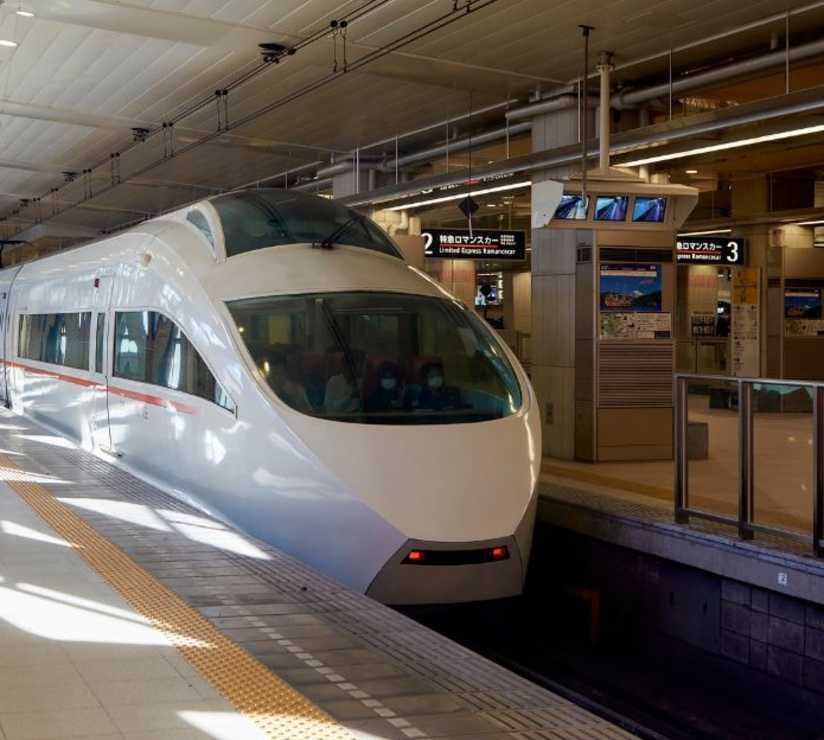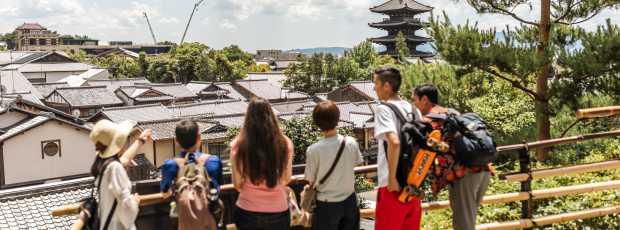We had a beautiful day full of unforgettable memories in Kyoto with our guide, Fumiko. She is such a kind and thoughtful person - it was truly a wonderful experience!Marie, Osaka, 2025
Table Of Contents
- Why This Day Trip Works
- Starting at Kyoto Station
- Morning Plan: Osaka Castle + Neighborhood Stroll
- Midday Markets and Street Food
- Hidden Observatories and Skyline Views
- Quick Culture Hit: Museums or Temples
- Late Afternoon: Dotonbori + Neon Lights
- What I'd Do Differently
- Planning Your Own Perfect Day

View from Kyoto Tower facing west toward Osaka
As someone who has lived in Osaka for over 15 years, I've seen that visitors often pack too many activities into their itineraries.
Let me share something counterintuitive: you can feel Osaka’s unique energy in just one day if you plan efficiently.
I can guarantee that a day trip to Osaka from Kyoto can give you the perfect balance of convenience and cultural contrast that makes Japanese urban exploration so rewarding.
Why This Day Trip Works

Timetable board showing frequent trains from Kyoto to Osaka. Photo by G N Pexels
Kyoto and Osaka sit just 30 minutes apart by train, but they feel like completely different worlds. Where Kyoto moves with the measured pace of tradition, Osaka pulses with modern energy. This proximity means you won't waste precious vacation hours on transit.
The contrast is what makes this journey worthwhile. After experiencing Kyoto's refined temples and gardens, Osaka's vibrant streets and boisterous atmosphere offer a welcome change.
These two cities perfectly complement each other, and gives you a closer look at how unique a visit to Japan can be.
One day is sufficient to understand what makes Osaka tick.
While residents like me could show you endless off-the-beaten-path spots, the city's distinctive character reveals itself quickly through its architecture, food culture, and the friendly and welcoming locals in Osaka.
Make the Most of Your Osaka Day
Make your trip from Kyoto count with a personalized experience shaped around you.
Starting at Kyoto Station

Inside Kyoto Station at 8am Image by Albrecht Fietz from Pixabay
For the efficient travel from Kyoto to Osaka, aim to depart Kyoto Station between 7:30-8:30am. The station is well-marked with English signage, but still arrive with at least 15 minutes to spare before your intended departure.
This early start is key to making the most of your time, especially if you plan to visit multiple major sites and enjoy the city's famous culinary scene without feeling rushed.
Kyoto Station itself is an impressive modern design, so even your arrival there can be part of the experience.
Take a moment to appreciate its scale and various levels before heading to your train.
If you have a JR Pass, this journey is fully covered.
Head to the JR ticket gates (not the subway or private railway lines) and look for platforms serving the JR Kyoto Line.
Trains depart approximately every 10 minutes during morning hours.
When you exit at Osaka Station, you're stepping into one of Japan's busiest transport hubs.

Bullet Train
You have two main options:
1. Local JR train: Takes about 30 minutes to Osaka Station and stops at several stations along the way. This is my recommendation for morning travel, as trains run frequently and are rarely crowded outside rush hour. The local train offers a glimpse into suburban Japanese life as you pass through smaller towns.
It's a comfortable ride, and the frequent departures mean you won't be stressed about missing a specific train. The local train offers a glimpse into suburban Japanese life as you pass through smaller towns. Also, it's a comfortable ride, and the frequent departures mean you won't be stressed about missing a specific train.
2. Shinkansen (bullet train): Takes only 15 minutes but requires seat reservations and runs less frequently. While the bullet train is an experience itself, it's actually overkill for this short distance and adds unnecessary complexity.
Unless you have a very tight schedule or are simply curious about the Shinkansen experience, the local JR train is the more practical and economical choice for this specific route. Plus, it's often easier to navigate the platforms for local trains, particularly during peak travel times.
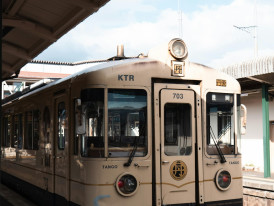
Local Train Photo by huuhuynh Pexels
When you exit at Osaka Station (sometimes called Umeda Station by locals), you're stepping into one of Japan's busiest transport hubs. Don't worry - the station is well-designed for flow despite its size.
A common point of confusion: Osaka Station and Umeda Station are technically different stations but connected underground.
Osaka is the JR station where you'll arrive from Kyoto, while Umeda serves private railways and subway lines.
For practical purposes, the entire complex functions as one massive station. Understanding this distinction is helpful for navigation.
Your Osaka Day, Designed Around You
Make the most of your Kyoto–Osaka trip with a local host who plans an experience shaped around what you love, not the usual stops.

Map of JR lines and Osaka metro near Umeda Photo by Enric Cruz López Pexels
Umeda is a sprawling underground labyrinth, but once you get your bearings, it offers seamless connections to almost anywhere in the city. Don't hesitate to use station maps, often available at information counters or via smartphone apps, to find your way.
If you don't already have an IC card (like ICOCA, Suica, or PASMO), consider purchasing one at the station.
While individual tickets work fine, an IC card speeds up transfers between the JR lines and Osaka Metro subway system, which you'll likely use throughout the day.
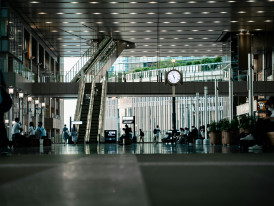
Crowds moving through Osaka Station Photo by Satoshi Hirayama Pexels
For orientation, the station has a north and south side.
The south exit leads toward the shopping districts and Umeda Sky Building, while the east side connects to the subway's Midosuji Line - Osaka's main artery that runs north-south through the city center.
The Midosuji Line is particularly important for tourists as it connects many of Osaka's major attractions, including Shin-Osaka (Shinkansen station), Umeda, Namba, and Tennoji.
Familiarizing yourself with its route will save you valuable time and simplify your travels.
Morning Plan: Osaka Castle + Neighborhood Stroll

Osaka Castle with clear skies Photo by Thành Văn Đình Pexels
From Osaka Station, take the Osaka Loop Line (JR) to Osakajokoen Station (about 10 minutes) or the Tanimachi subway line to Tanimachi 4-chome Station. Both put you within a short walk of Osaka Castle.
Yes, Osaka Castle is reconstructed rather than original, and yes, it's a popular tourist spot. But there's a reason locals like myself still recommend it. The grounds offer an excellent introduction to the city's scale and history.
The castle opens at 9:00am, and arriving before 10:00am helps you avoid school groups.
Rather than rushing straight inside, first walk the spacious park grounds. The stone walls and moat system are impressive engineering feats that predate the current structure.
In spring, this area becomes one of the city's premier cherry blossom viewing spots. During autumn, the ginkgo trees around the castle transform into a spectacular golden display.
The sheer size of the stone walls, some of which are among the largest in Japan, truly conveys the power and ambition of the feudal lords who built them.
After exploring the castle (for about 60-90 minutes total), stop at one of the small coffee stands near the south exit of the park.
My preference is the family-run stall that serves iced coffee in summer and hot sweet potatoes in winter - just look for the line of office workers during break time.

Locals jogging or strolling in the castle park photo by Photo by William Mortlock Pexels
Midday Markets and Street Food
Now it's time to discover firsthand why Osaka is called "Japan's kitchen." Take the Chuo subway line from Tanimachi 4-chome to Nipponbashi Station for Kuromon Market, or to Dobutsuen-mae for Shinsekai district.
Kuromon Market functions as the city's central food market and offers a more organized experience. The covered arcade stretches for several blocks with over 150 shops and stalls.
The focus is on seafood here - the market's specialty - where you can find everything from fresh oysters to grilled scallops.
This is a great spot to taste local street food. Beyond seafood, you'll also find traditional Japanese sweets, and various prepared foods. Don't be afraid to try samples where offered; it's a great way to discover new flavors.
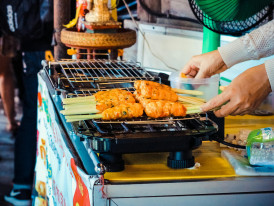
Vendor grilling takoyaki. Photo by Nam Phong Bùi Pexels
If you prefer something slightly grittier and more local, choose Shinsekai instead.
This retro district developed before World War II and somehow maintained its Showa-era atmosphere. Here you'll find kushikatsu (deep-fried skewered meat and vegetables), a working-class food that's pure Osaka.
Whichever you choose, don't miss trying takoyaki (octopus balls).
The best stalls have a constant queue and prepare them fresh. When a vendor hands you the paper boat of steaming takoyaki, wait a minute before taking a bite - the centers are molten hot!
A local tip: Osakans eat while walking more than people in other Japanese cities. It's not considered rude here, especially in these food-focused districts.

Crowds at Kuromon Market photo by Photo by Satoshi Hirayama Pexels
Get a Local’s Take on Osaka in Just 3 Hours
Plan your day with a host who’ll show you the city’s character - not just a checklist.
Hidden Observatories and Skyline Views
After filling up on street food, it's time to gain some perspective. Head back north to the Umeda district to visit the Floating Garden Observatory at Umeda Sky Building.
Take the Midosuji subway line to Umeda Station, then walk about 10 minutes west of the station. The building itself is architecturally significant - two towers connected by a floating garden observatory 173 meters above ground.
The open-air deck offers 360-degree views of the urban sprawl stretching toward the mountains and sea.
The escalators and glass elevator ride to the top are half the experience, as they're engineered to create a sense of floating in space. Admission costs 1,500 yen, which is standard for Japanese observatories, and the views justify the price.
If heights aren't your thing or you prefer a less touristy alternative, consider the High Five Ferris Wheel instead.
Located on top of a shopping mall near Umeda Station, this bright red wheel provides similar views at a lower height and half the price of the Sky Building.

Modern museum facade in Osaka Photo by Bergmann Creative Commons Attribution-Share Alike 3.0
Quick Culture Hit: Museums or Temples
By mid-afternoon, you'll want a break from walking. Depending on your interests, Osaka offers several world-class but manageable cultural stops.
For contemporary art enthusiasts, the National Museum of Art, Osaka is conveniently underground (literally, the building is subterranean with only a sculptural entrance visible aboveground) near Higobashi Station on the Yotsubashi Line.
The compact size means you can appreciate the rotating exhibitions in about an hour.
If traditional culture interests you more, Shitennoji Temple in the Tennoji area is Japan's oldest officially administered temple, founded in 593.
Unlike Kyoto's temples, Shitennoji has a straightforward, down-to-earth fee that reflects Osaka's character. Take the Tanimachi Line to Shitennoji-mae Yuhigaoka Station.
Less interested in art or religion? The Kamigata Ukiyoe Museum in the Namba district showcases traditional woodblock prints with a focus on Osaka's theatrical history.
It's small enough to enjoy in 30-45 minutes and rarely crowded.
Whichever you choose, plan for about 60-90 minutes including transit time. This leaves you conveniently located for your next stop of your day.

Dotonbori at twilight. Photo by Satoshi Hirayama Pexels
Late Afternoon: Dotonbori + Neon Lights
As the afternoon transitions to evening, make your way to Dotonbori. This is timing strategic - the neon lights begin illuminating around 5:00pm in winter and 7:00pm in summer, but the area grows increasingly crowded after 8:00pm.
Take the Midosuji Line to Namba Station and follow the crowds east. Dotonbori runs parallel to a canal, with the most photographed section being the bridge where the giant Glico "running man" sign has advertised energy drinks since 1935.
This is Osaka at its most theatrical. Giant mechanical crabs move above seafood restaurants, a massive octopus clings to another building, and the canal reflects the multicolored signs in a blur of light. It's sensory overload in the best possible way.
Food options abound, from high-end crab restaurants to casual okonomiyaki (savory pancake) counters.
If you're still full from lunch, simply grab a small snack like melon pan (a sweet bun) from a street vendor.
The side streets off Dotonbori offer less touristy options and local shopping.
Wander through the covered Sennichimae shopping street or explore the back alleys where small izakayas (pubs) are beginning their evening service.
More than 26,240 5-star reviews and counting
26,240+ 5-Star Reviews and Counting
Trusted and recommended by travelers worldwide.

People crossing bridge at night
After experiencing Osaka's electric evening atmosphere, it's time to head back to Kyoto. You have several convenient options:
From Namba Station, take the Midosuji subway line north to Osaka Station (about 15 minutes), then transfer to the JR Kyoto Line back to Kyoto.
Alternatively, if you're still in the Dotonbori area, you can walk to Namba Station and take a direct JR train from nearby JR Namba Station to Kyoto (though these run less frequently than from Osaka Station).
The last regular trains from Osaka to Kyoto depart around midnight, but I recommend catching one no later than 10:30pm for comfort.
Trains leaving between 7:00-9:00pm tend to be less crowded than later departures, when the after-work drinking crowd heads home.
If you have a JR Pass, remember it covers your return journey on JR lines but not on private railways or subways. The trip takes approximately the same time as your morning journey - about 30 minutes on a regular JR train.

View from a train window back to Kyoto Photo by Peter Thomas on Unsplash
What I'd Do Differently
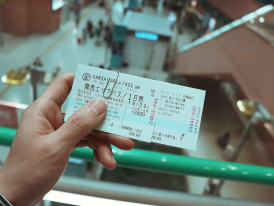
Hand holding a transport ticket Photo by 戸山 神奈 on Unsplash
Having guided many friends through this Kyoto to Osaka day trip itinerary over the years, I've noticed a few common regrets:
First, most travelers underestimate the walking involved. Osaka's attractions may seem close on a map, but the city's scale is deceptive.
Consider using the excellent subway system even for distances that seem walkable.
Second, many visitors try to squeeze in too many major sights. One castle, one market area, one observatory, and one entertainment district make for a full but manageable day.
Adding Tennoji Zoo or Universal Studios would transform this into a rushed experience.
Finally, evening departure times often slide later as visitors get caught up in Dotonbori's energy.
Set an alarm on your phone as a reminder, as the last train to Kyoto waits for no one, and taxi fares between cities are prohibitively expensive.
If this one day Osaka itinerary leaves you wanting more, that's actually perfect.
Osaka offers plenty for repeat visitors to explore that isn't immediately apparent. The city's charm becomes clearer the more you explore, from the food alleys of Tenma to the historic streets of Nakazakicho.
Planning Your Own Perfect Day
A one day Osaka itinerary from Kyoto gives you a good first look at Osaka as Japan's most underrated city. You'll experience its history at Osaka Castle, its culinary culture at the markets, its modern architecture at the observatories, and its vibrant nightlife in Dotonbori.
What makes Osaka special isn't any single attraction but the city's distinctive character. In just one day, you'll feel the difference between Kyoto's refined restraint and Osaka's straightforward energy.
For those wanting to explore further, consider our guide to things to do in Osaka or browse other Osaka experiences that go above and beyond the standard tourist trail.
Whether this day trip is your only taste of Osaka or the beginning of a stronger connection to the city, you'll come away understanding why many Japanese consider it the nation's most genuine city experience.
Safe travels, and as we say in Osaka: "Maido!" (Thanks always!)
One Day. One Local. One Unforgettable Way to Explore Osaka.
SEE OSAKA EXPERIENCESSee Osaka Through Local Eyes, Even on a Day Trip
City Unscripted pairs you with a local host who plans your visit around what you love. No scripts, no schedules, just your kind of day.
Thinking Ahead to Osaka?
Chat with a local who’ll help you plan a trip shaped around what you want, not a pre-set plan.
